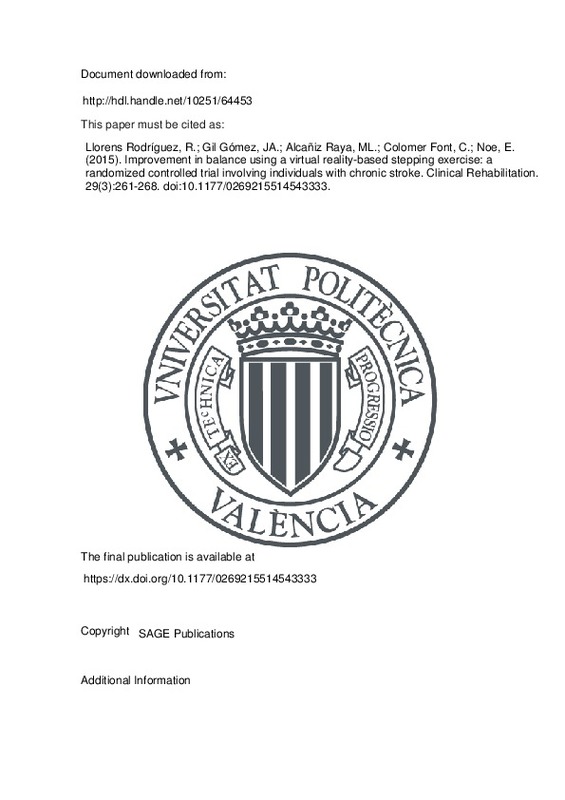Navarro, M.-D., Lloréns, R., Noé, E., Ferri, J., & Alcañiz, M. (2013). Validation of a low-cost virtual reality system for training street-crossing. A comparative study in healthy, neglected and non-neglected stroke individuals. Neuropsychological Rehabilitation, 23(4), 597-618. doi:10.1080/09602011.2013.806269
Maclean, N., Pound, P., Wolfe, C., & Rudd, A. (2002). The Concept of Patient Motivation. Stroke, 33(2), 444-448. doi:10.1161/hs0202.102367
Henderson, A., Korner-Bitensky, N., & Levin, M. (2007). Virtual Reality in Stroke Rehabilitation: A Systematic Review of its Effectiveness for Upper Limb Motor Recovery. Topics in Stroke Rehabilitation, 14(2), 52-61. doi:10.1310/tsr1402-52
[+]
Navarro, M.-D., Lloréns, R., Noé, E., Ferri, J., & Alcañiz, M. (2013). Validation of a low-cost virtual reality system for training street-crossing. A comparative study in healthy, neglected and non-neglected stroke individuals. Neuropsychological Rehabilitation, 23(4), 597-618. doi:10.1080/09602011.2013.806269
Maclean, N., Pound, P., Wolfe, C., & Rudd, A. (2002). The Concept of Patient Motivation. Stroke, 33(2), 444-448. doi:10.1161/hs0202.102367
Henderson, A., Korner-Bitensky, N., & Levin, M. (2007). Virtual Reality in Stroke Rehabilitation: A Systematic Review of its Effectiveness for Upper Limb Motor Recovery. Topics in Stroke Rehabilitation, 14(2), 52-61. doi:10.1310/tsr1402-52
Booth, V., Masud, T., Connell, L., & Bath-Hextall, F. (2013). The effectiveness of virtual reality interventions in improving balance in adults with impaired balance compared with standard or no treatment: a systematic review and meta-analysis. Clinical Rehabilitation, 28(5), 419-431. doi:10.1177/0269215513509389
Kim, J. H., Jang, S. H., Kim, C. S., Jung, J. H., & You, J. H. (2009). Use of Virtual Reality to Enhance Balance and Ambulation in Chronic Stroke: A Double-Blind, Randomized Controlled Study. American Journal of Physical Medicine & Rehabilitation, 88(9), 693-701. doi:10.1097/phm.0b013e3181b33350
Haas, B. M., & Burden, A. M. (2000). Validity of weight distribution and sway measurements of the Balance Performance Monitor. Physiotherapy Research International, 5(1), 19-32. doi:10.1002/pri.181
Srivastava, A., Taly, A. B., Gupta, A., Kumar, S., & Murali, T. (2009). Post-stroke balance training: Role of force platform with visual feedback technique. Journal of the Neurological Sciences, 287(1-2), 89-93. doi:10.1016/j.jns.2009.08.051
Gil-Gómez, J.-A., Lloréns, R., Alcañiz, M., & Colomer, C. (2011). Effectiveness of a Wii balance board-based system (eBaViR) for balance rehabilitation: a pilot randomized clinical trial in patients with acquired brain injury. Journal of NeuroEngineering and Rehabilitation, 8(1), 30. doi:10.1186/1743-0003-8-30
Lloréns, R., Colomer-Font, C., Alcañiz, M., & Noé-Sebastián, E. (2013). BioTrak: análisis de efectividad y satisfacción de un sistema de realidad virtual para la rehabilitación del equilibrio en pacientes con daño cerebral. Neurología, 28(5), 268-275. doi:10.1016/j.nrl.2012.04.016
Folstein, M. F., Folstein, S. E., & McHugh, P. R. (1975). «Mini-mental state». Journal of Psychiatric Research, 12(3), 189-198. doi:10.1016/0022-3956(75)90026-6
Tyson, S. F., & DeSouza, L. H. (2004). Development of the Brunel Balance Assessment: a new measure of balance disability post stroke. Clinical Rehabilitation, 18(7), 801-810. doi:10.1191/0269215504cr744oa
Romero, M., Sánchez, A., Marín, C., Navarro, M. D., Ferri, J., & Noé, E. (2012). Utilidad clínica de la versión en castellano del Mississippi Aphasia Screening Test (MASTsp): validación en pacientes con ictus. Neurología, 27(4), 216-224. doi:10.1016/j.nrl.2011.06.006
Tinetti, M. E. (1986). Performance-Oriented Assessment of Mobility Problems in Elderly Patients. Journal of the American Geriatrics Society, 34(2), 119-126. doi:10.1111/j.1532-5415.1986.tb05480.x
Rossier, P., & Wade, D. T. (2001). Validity and reliability comparison of 4 mobility measures in patients presenting with neurologic impairment. Archives of Physical Medicine and Rehabilitation, 82(1), 9-13. doi:10.1053/apmr.2001.9396
Kizony, R., Raz, L., Katz, N., Weingarden, H., & Weiss, P. L. T. (2005). Video-capture virtual reality system for patients with paraplegic spinal cord injury. The Journal of Rehabilitation Research and Development, 42(5), 595. doi:10.1682/jrrd.2005.01.0023
Yavuzer, G., Eser, F., Karakus, D., Karaoglan, B., & Stam, H. J. (2006). The effects of balance training on gait late after stroke: a randomized controlled trial. Clinical Rehabilitation, 20(11), 960-969. doi:10.1177/0269215506070315
Mercer, V. S., Freburger, J. K., Chang, S.-H., & Purser, J. L. (2009). Measurement of Paretic-Lower-Extremity Loading and Weight Transfer After Stroke. Physical Therapy, 89(7), 653-664. doi:10.2522/ptj.20080230
Ng, S. (2010). Balance Ability, Not Muscle Strength and Exercise Endurance, Determines the Performance of Hemiparetic Subjects on the Timed-Sit-to-Stand Test. American Journal of Physical Medicine & Rehabilitation, 89(6), 497-504. doi:10.1097/phm.0b013e3181d3e90a
Yang, Y.-R., Tsai, M.-P., Chuang, T.-Y., Sung, W.-H., & Wang, R.-Y. (2008). Virtual reality-based training improves community ambulation in individuals with stroke: A randomized controlled trial. Gait & Posture, 28(2), 201-206. doi:10.1016/j.gaitpost.2007.11.007
[-]







![[Cerrado]](/themes/UPV/images/candado.png)


